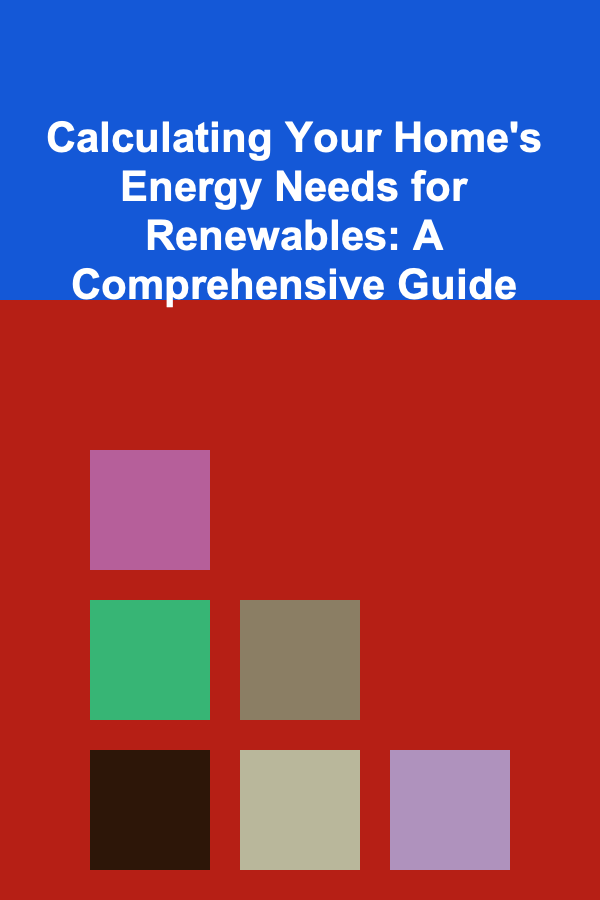
Calculating Your Home's Energy Needs for Renewables: A Comprehensive Guide
ebook include PDF & Audio bundle (Micro Guide)
$12.99$5.99
Limited Time Offer! Order within the next:

Transitioning to renewable energy sources like solar, wind, or geothermal is a significant step towards a sustainable future. However, before investing in a renewable energy system, it's crucial to accurately determine your home's energy consumption and needs. This detailed guide will walk you through the process of calculating your energy requirements and assessing the feasibility of incorporating renewable energy into your home.
Why Calculate Your Energy Needs?
Understanding your energy consumption is paramount for several reasons:
- System Sizing: The size of your renewable energy system (e.g., solar panel array, wind turbine) must be appropriately matched to your energy demand. An undersized system won't meet your needs, while an oversized system represents unnecessary expense and potential energy waste.
- Cost-Effectiveness: Knowing your energy needs helps you determine the return on investment (ROI) for a renewable energy system. You can accurately estimate savings on electricity bills and compare them to the system's installation and maintenance costs.
- Grid Interconnection: If you plan to connect your renewable energy system to the utility grid (net metering), understanding your consumption patterns is essential for determining how much excess energy you'll send back to the grid and the corresponding credits you'll receive.
- Energy Efficiency: The calculation process often reveals areas where you can reduce energy consumption through energy-efficient appliances, insulation, and behavioral changes. Reducing consumption before investing in renewables makes the system more affordable and effective.
- Environmental Impact: A properly sized system reduces your reliance on fossil fuels, minimizing your carbon footprint and contributing to a cleaner environment. Knowing your energy usage allows you to quantify the environmental benefits of your renewable energy adoption.
Gathering Your Energy Consumption Data
The most accurate way to determine your energy needs is to analyze your historical electricity bills. Here's how:
2.1 Reviewing Your Electricity Bills
Collect electricity bills for the past 12 months. Most utilities provide monthly statements that include the following essential information:
- kWh (Kilowatt-hours) Consumed: This is the unit of energy your utility charges you for. Note the kWh consumed for each month.
- Billing Period: The dates covered by the bill. This is important for calculating daily or weekly averages.
- Demand (kW): (Less common for residential customers, but still important if present). This is the peak rate at which you used energy during the billing period. High demand charges can impact the economic viability of certain renewable energy systems.
- Cost per kWh: The price you pay for each kilowatt-hour of electricity. This can vary depending on time of day, usage tiers, and other factors.
Example: Let's say your January bill shows 1200 kWh consumed, and your July bill shows 1800 kWh consumed. This indicates a significant difference in energy usage between winter and summer months, likely due to heating and cooling needs.
2.2 Creating a Spreadsheet
Organize your data in a spreadsheet (e.g., Excel, Google Sheets). Create columns for:
- Month
- kWh Consumed
- Billing Period (Start Date, End Date)
- Days in Billing Period
- Average Daily Consumption (kWh/day)
Calculate the average daily consumption for each month by dividing the kWh consumed by the number of days in the billing period.
2.3 Analyzing Your Consumption Patterns
Examine your spreadsheet to identify trends and patterns in your energy consumption:
- Seasonal Variations: Do you use more energy in the summer for air conditioning or in the winter for heating? Identify peak consumption months and low consumption months.
- Monthly Averages: Calculate the average monthly consumption over the past year. This is a good starting point for estimating your overall energy needs.
- Daily Averages: Determine your average daily consumption, which is useful for sizing battery storage systems or understanding peak energy demands.
- Base Load: This is the minimum amount of energy you consistently use. It's often due to appliances that run continuously, like refrigerators, freezers, and some electronics. Identifying your base load is crucial for designing an off-grid system.
Example: Your spreadsheet might reveal that you consume an average of 1500 kWh per month, with a peak of 2000 kWh in July and a low of 1000 kWh in April. Your average daily consumption might be around 50 kWh.
2.4 Using Online Energy Calculators
Many utilities and government agencies offer online energy calculators that can help you estimate your energy consumption. These calculators typically ask for information about your:
- Home size (square footage)
- Number of occupants
- Types of appliances
- Insulation levels
- Heating and cooling systems
- Lighting
- Geographic location
While these calculators provide a general estimate, they are less accurate than analyzing your actual electricity bills. Use them as a supplementary tool for comparison.
2.5 Energy Audits
A professional energy audit is a comprehensive assessment of your home's energy efficiency. A certified energy auditor will inspect your home for:
- Air leaks
- Insulation levels
- Inefficient appliances
- Drafty windows and doors
- Inefficient heating and cooling systems
The auditor will provide a detailed report with recommendations for improving energy efficiency. While an energy audit costs money, the long-term savings on energy bills can often outweigh the initial investment. Moreover, the information gained is invaluable for accurately assessing your true energy needs rather than just historical consumption.
Identifying Your Energy-Consuming Appliances
To gain a deeper understanding of your energy consumption, identify your major energy-consuming appliances and estimate their individual usage.
3.1 Major Appliances
The following appliances typically account for the bulk of residential energy consumption:
- Heating and Cooling Systems: Furnaces, air conditioners, heat pumps, and electric baseboard heaters.
- Water Heater: Electric, gas, or tankless water heaters.
- Refrigerator and Freezer: Essential appliances that run constantly.
- Clothes Washer and Dryer: Consider energy-efficient models.
- Dishwasher: Use energy-saving settings.
- Oven and Stove: Electric or gas.
- Lighting: Switch to LED bulbs.
- Electronics: TVs, computers, gaming consoles, and other devices.
3.2 Estimating Appliance Energy Usage
There are several ways to estimate appliance energy usage:
- Appliance Labels: Look for the EnergyGuide label on your appliances. This label provides an estimated annual energy consumption in kWh. Keep in mind that this is just an estimate, and your actual usage may vary.
- Manufacturer Specifications: Consult the appliance's manual or the manufacturer's website for detailed energy consumption information. They often provide wattage (W) ratings.
- Energy Monitoring Devices: Plug-in energy monitors, like Kill-A-Watt meters, can measure the actual energy consumption of individual appliances. This is the most accurate way to determine appliance energy usage.
- Calculating Energy Consumption: If you know the appliance's wattage and the number of hours it's used per day, you can estimate its daily energy consumption using the following formula:
Energy Consumption (kWh/day) = (Wattage (W) x Hours of Use per Day) / 1000
Example: A 100-watt light bulb that's used for 4 hours a day consumes (100 W x 4 hours) / 1000 = 0.4 kWh per day.
3.3 Creating an Appliance Energy Consumption Table
Create a table listing your major appliances and their estimated energy consumption:
| Appliance | Wattage (W) | Hours of Use per Day | Daily Energy Consumption (kWh) | Monthly Energy Consumption (kWh) | |---------------------------|-------------|----------------------|--------------------------------|----------------------------------| | Refrigerator | 150 | 24 (continuous) | 3.6 | 108 | | Air Conditioner (Central) | 3000 | 6 (summer only) | 18 (summer only) | 540 (summer only) | | Washing Machine | 500 | 1 | 0.5 | 15 | | Total | | | | (Calculate Sum) |
Sum the monthly energy consumption for all appliances to estimate your total monthly appliance energy consumption. Compare this estimate to your actual monthly energy consumption from your utility bills. Any discrepancies may be due to appliances you haven't accounted for or inaccuracies in your estimates.
Accounting for Future Energy Needs
Consider any potential changes in your energy consumption in the future:
- New Appliances: Are you planning to purchase any new appliances, such as an electric vehicle (EV) charger, a hot tub, or a new computer? Factor in the energy consumption of these appliances.
- Changes in Occupancy: Will the number of occupants in your home increase or decrease? More occupants typically mean higher energy consumption.
- Home Renovations: Will you be renovating your home? Consider energy-efficient upgrades, such as improved insulation, new windows, or a more efficient heating and cooling system.
- Lifestyle Changes: Will your lifestyle change in a way that affects your energy consumption? For example, will you be working from home more often, requiring more electricity for lighting and electronics?
Add a buffer to your energy consumption estimates to account for these potential changes. A 10-20% buffer is generally recommended.
Assessing Renewable Energy Potential
Once you've calculated your home's energy needs, you can assess the feasibility of using renewable energy to meet those needs.
5.1 Solar Energy
Solar energy is the most popular renewable energy option for homeowners. Here's how to assess your solar energy potential:
- Sunlight Availability: How much sunlight does your roof receive? South-facing roofs generally receive the most sunlight. Use online tools like Google Project Sunroof or PVWatts to estimate your roof's solar potential. These tools take into account your location, roof orientation, shading, and other factors.
- Roof Size and Orientation: The size and orientation of your roof will determine how many solar panels you can install. A larger roof with a south-facing orientation is ideal.
- Shading: Trees, buildings, and other obstructions can shade your roof and reduce solar panel output. Trim trees or consider other shading solutions.
- Local Solar Incentives: Check for local, state, and federal solar incentives, such as tax credits, rebates, and net metering programs. These incentives can significantly reduce the cost of solar panel installation.
5.2 Wind Energy
Wind energy is another renewable energy option, but it's typically less suitable for residential applications due to space requirements and noise concerns. Here's how to assess your wind energy potential:
- Wind Speed: Wind turbines require consistent wind speeds to generate electricity. Check local wind speed maps or use an anemometer to measure wind speeds at your location. A minimum average wind speed of 10 mph is generally required.
- Turbine Height: Wind speed increases with height. Taller turbines generate more electricity.
- Zoning Regulations: Check local zoning regulations to ensure that wind turbines are permitted in your area.
- Noise Levels: Wind turbines can be noisy. Consider the noise levels and potential impact on your neighbors.
5.3 Geothermal Energy
Geothermal energy uses the earth's constant temperature to heat and cool your home. It's a highly efficient and environmentally friendly option, but it requires a significant upfront investment.
- Ground Conditions: The type of soil and groundwater conditions can affect the performance of a geothermal system.
- Land Availability: Geothermal systems require space for underground piping.
- Installation Costs: Geothermal systems are more expensive to install than traditional heating and cooling systems.
Matching Renewable Energy Output to Your Needs
The final step is to determine how much renewable energy you need to generate to meet your home's energy needs. This involves considering the output of your chosen renewable energy system and the availability of net metering programs.
6.1 Estimating Renewable Energy System Output
Use online calculators or consult with a renewable energy installer to estimate the output of your chosen renewable energy system. These estimates will depend on factors such as:
- System Size: The capacity of the system (e.g., kW for solar panels, kW for wind turbine).
- Location: Sunlight hours, wind speed, and other local conditions.
- System Efficiency: The efficiency of the components (e.g., solar panel efficiency, inverter efficiency).
Example: A 5 kW solar panel system in a sunny location might generate approximately 6,500 kWh of electricity per year.
6.2 Net Metering
Net metering allows you to send excess electricity generated by your renewable energy system back to the utility grid in exchange for credits on your electricity bill. This is a significant benefit, as it allows you to offset your electricity consumption and reduce your overall energy costs.
Check with your local utility to determine the availability and terms of their net metering program. Some utilities offer full retail credit for excess electricity, while others offer a wholesale rate.
6.3 Determining System Size
Based on your energy needs and the estimated output of your renewable energy system, you can determine the appropriate system size. The goal is to size the system to meet your annual energy needs while taking into account net metering and potential future changes in energy consumption.
Example: If you consume 12,000 kWh of electricity per year and a 5 kW solar panel system generates 6,500 kWh per year, you would need to purchase the remaining 5,500 kWh from the utility grid. You could consider installing a larger solar panel system or implementing energy-saving measures to reduce your energy consumption.
Conclusion
Calculating your home's energy needs for renewables is a crucial step in making informed decisions about investing in sustainable energy solutions. By meticulously gathering and analyzing your energy consumption data, understanding your appliance usage, accounting for future changes, and assessing your renewable energy potential, you can accurately determine the appropriate size and type of renewable energy system for your home. Remember to consult with qualified professionals for expert advice and installation services. With careful planning and execution, you can significantly reduce your reliance on fossil fuels, lower your energy bills, and contribute to a cleaner and more sustainable future.
Reading More From Our Other Websites
- [Organization Tip 101] How to Organize Social Media Promotions for Volunteer Events
- [Home Party Planning 101] How to Plan a Kid-Friendly Party with Fun Activities
- [Gardening 101] Top 10 Soil Mix Recipes for Thriving Raised‑Bed Plants
- [Survival Kit 101] Best High‑Altitude Survival Kit for Mountaineers Facing Sudden Weather Shifts
- [Polymer Clay Modeling Tip 101] From Sculpt to Spotlight: Rising Stars in the Polymer Clay Community
- [Organization Tip 101] How to Create a Relaxation Space with Luxury Elements
- [Personal Care Tips 101] How to Use Blush to Complement Your Eye Makeup
- [Home Pet Care 101] How to Set Up a Pet Activity Zone for Fun and Exercise
- [Personal Care Tips 101] How to Take Care of Sensitive Skin: A Gentle Approach
- [Home Space Saving 101] How to Organize Space-Saving Toy Storage Ideas for Kids' Rooms

How to Build a Completely Renewable Energy Powered Home
Read More
How to Build Relationships with Local Businesses for Camp Support
Read More
How to Create a Spa-Like Bathroom with Proper Lighting
Read More
How to Monetize Your Deep Learning Skills for Extra Income
Read More
How To Track Your Language Learning Progress
Read More
10 Tips for Creating Geometric Tie-Dye Patterns
Read MoreOther Products

How to Build a Completely Renewable Energy Powered Home
Read More
How to Build Relationships with Local Businesses for Camp Support
Read More
How to Create a Spa-Like Bathroom with Proper Lighting
Read More
How to Monetize Your Deep Learning Skills for Extra Income
Read More
How To Track Your Language Learning Progress
Read More